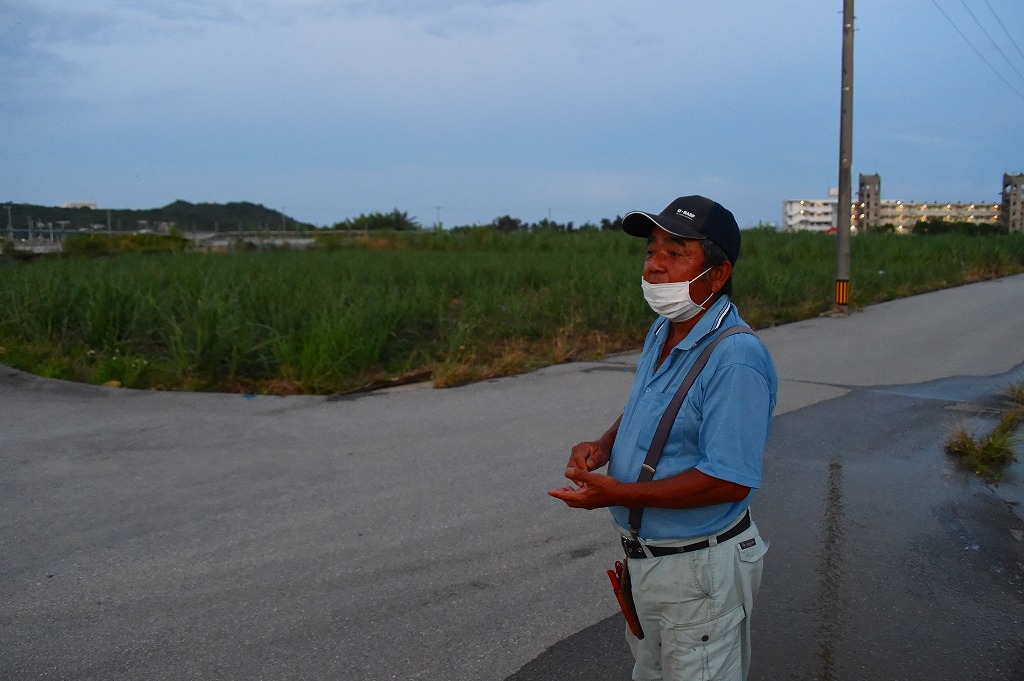Chrysanthemum farmer has to dispose of 15% of his stock as coronavirus causes decrease in public funerals, participation in tomb sweeping festival

Satoshi Miyahira, whose fields were damaged by flooding after a major rain storm – Nanjo
May 27, 2020 Ryukyu Shimpo
By Daitetsu Teruya and Sanenori Kinjo
Nanbu – Chrysanthemum farmers, who were already facing a harsh business environment due to low prices in recent years, have taken a major hit due to the effects of the coronavirus. With the declaration of a state emergency, in order to prevent the “three densities” (closed spaces, crowds, and close contact), there has been a significant decrease in funerals, the major drivers of demand for chrysanthemums in Japan. In Okinawa, they have also been affected by people refraining from participating in the grave sweeping festival. For a small chrysanthemum owner in Nanbu, this meant disposing of up to 15% of his stock of flowers, being unable to sell them. With the decrease in revenue, the farm is now in a life or death struggle.
According to the farmer, the price for chrysanthemums has been on a downward trend since 2010, just before the Tohoku earthquake. Decades ago, the price for one flower was around 60 yen, but has since fallen to just around 30, and is expected to drop to 20 yen. An uncertain future has led to anxiety, he wonders, “How long will this feeling be with me?” Leaning on the used truck he has lovingly relied on for 10 years, he hangs his head.
The profit for the year was 500,000 yen
While the revenue decreased, costs continue to rise. The cost of pesticides and shipping fees to carry the flowers outside of Okinawa rise each year. The mounting costs continue to put pressure on his livelihood.
Furthermore, “The past two, three years we have been hit with typhoons.” Equipment such as the nets that surround the fields were destroyed. Due to repairs the costs never stop. They are somehow getting by on the pension of his mother, who lives with him.
Due to the coronavirus, 15% of the chrysanthemums he grew had to be disposed of. There are other farmers who had to dispose of as much as 40% of their stock. After calculating all the annual costs, he was left with only 500,000 yen on hand. The farmer said strongly, “It’s unthinkable. The past few years has been mind-blowing.”
Unable to ship vegetables for school lunch
An array of flowering plants and vegetables such as chrysanthemums, lisianthus, okra, and green peppers color the fields. For Satoshi Miyahira, 65, who operates a farm in Tamagusuku, Nanjo along with his sons, the coronavirus pandemic has been a huge shock. Shipments of chrysanthemums outside of Okinawa ended around March and April, and with the schools closing, so did the shipments of their vegetables used in school lunches. “I have been running this farm for close to 50 years, but this is the first time I have seen this type of damage,” he said, shrugging his shoulders.
Miyahira was also hit with flooding in his fields after a record-setting rain on May 2 and 6, damaging part of his produce and flowers. With heavy rainstorms increasing, and the timeframe for produce becoming earlier, he is feeling the effects of climate change.
Because his farm is a vital part of supporting people’s food supply, he warns, “If we can’t create an environment for us to farm with stability, the number of people who go into farming will continue to decrease.”
(English translation by T&CT and Sam Grieb)
Previous Article:Drive-thru giveaway: come get a free tadpole or beetle from this local breeder
Next Article:Thirty new names to be engraved on Cornerstone of Peace, bringing total to 241,593 names
[Similar Articles]
- Sunflowers at night: chrysanthemum farmer grows 50,000 sunflowers as a secondary crop
- Okinawa chrysanthemums hit peak shipping period in lead up to Higan holiday, extra shipping flights also being scheduled
- A reduction in tourist visitors to Okinawa due to coronavirus, anticipated to be around 500,000, could lead to a decrease in tourism revenue of 28.1 billion yen, cause 1,940 job losses
- Lack of rain damages sugarcane and vegetables in Okinawa
- JAL puts on a special cargo service to get New Year chrysanthemums from Okinawa to all parts of the country
 Webcam(Kokusai Street)
Webcam(Kokusai Street)


